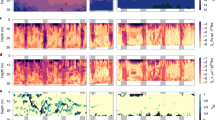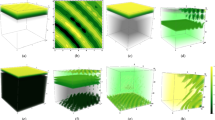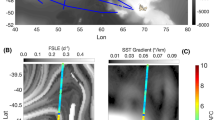Abstract
Bulk Theological properties of sea water sometimes change in phytoplankton blooms1–7, when the water has been described as viscous1, slimey2,3, ropey2–4 or like egg white4. Fishing nets have been clogged2,5,7 and broken2, and bubbles6 or solids2,4,5 have been trapped. Turbulent viscosity, however, can be reduced8. It has been suggested1,2,6 that phytoplankton mucus may kill marine animals by ‘clogging’ their gills. Yet oceanographers consider the sea to be newtonian, that is without rigidity and with dynamic viscosity, η, independent of shear rate, γ. I show here that out of eight phytoplankton cultures investigated, η increased with decreasing γ in three, and the highest value of η, found at γ = 0.017 s−1, was ∼400 times that found at unstated but probably high (102-5 x 103 s−1) values of γ by Miyaki and Koizumi9. Finite values of dynamic rigidity, G′′, were also observed. The characteristic length, L, and time, t, of Kolmogorov eddies10 are extremely sensitive to simulated γ-dependent η, and as the scales of many oceanic processes depend on L and r, the lack of rheometrical data at ambient γ could be detrimental to the modelling of these processes.
This is a preview of subscription content, access via your institution
Access options
Subscribe to this journal
Receive 51 print issues and online access
$199.00 per year
only $3.90 per issue
Buy this article
- Purchase on Springer Link
- Instant access to full article PDF
Prices may be subject to local taxes which are calculated during checkout
Similar content being viewed by others
References
Matsusato, T. & Kobayashi, H. Bull. Nansei reg. Fish. Res. Lab. No. 7, 43–67 (1974).
Subrahmanyan, R. Ind. J. Fish. 1, 182–203 (1954).
Hollande, A. & Enjumet, M. Bull. Stn Aquic. Peche Castiglione, N. Sér. No. 8, 271–280 (1956).
Dreyfuss, R. Cah. Cent. Etud. Rech. Biol. Océanogr. méd., Nice No. 1, 14–15 (1962).
Boalch, G. T. & Harbour, D. S. Nature 269, 687–688 (1977).
Jenkinson, I. R. & Connors, P. P. J. Sherkin Island 1(2), 1–19 (1980).
Chang, F. H. N. Z. J. mar. freshwat. Res. 17, 165–168 (1983).
Hoyt, J. W. Mar. Biol. Berlin. 7, 93–99 (1970).
Miyake, Y. & Koizumi, M. J. mar. Res. 7, 63–66 (1948).
Batchelor, G. K. The Theory of Homogeneous Turbulence (Cambridge University Press, 1970).
Van Leer, J. C. & Rooth, C. G. Deep-Sea Res. 22, 831–836 (1975).
Kitaigorodskii, S. A. J. phys. Oceanogr. 14, 960–972 (1984).
Crochet, M. J., Davies, A. R. & Walters, K. Numerical Simulation of Non-Newtonian Flow (Elsevier, Amsterdam, 1984).
Horne, R. A. Marine Chemistry (Wiley-Interscience, New York, 1969).
Beasley, K. M. in Rheometry: Industrial Applications (ed. Walters, K.) 339–413 (Research Studies Press, Chichester, 1980).
Oakey, N. S. J. phys. Oceanogr. 12, 256–271 (1982).
Gadd, G. E. Nature 206, 463–467 (1965).
Mitchell, J. G., Okubo, A. & Fuhrman, J. A. Nature 316, 58–59 (1985).
Margalef, R., Estrada, M. & Blasco, D. in Toxic Dinoflagellate Blooms (eds. Taylor, D. L. & Seliger, H. H.) 89–94 (Elsevier, Amsterdam, 1979).
Lancelot, C. Estuar. coast. Shelf Sci. 18, 593–600 (1984).
Fryxell, G. A., Gould, R. W. Jr, Balmori, E. R. & Theriot, E. C. J. Plankton Res. 7, 339–364 (1985).
Smetacek, V. S. Mar. Biol. Berlin 84, 239–251 (1985).
Jenkinson, I. R. Mar. Pollut. Bull. 3, 102–105 (1972).
Sharp, J. H. Limnol. Oceanogr. 22, 381–399 (1977).
Mague, J. H., Friberg, E., Hughes, D. J. & Morris, I. Limnol. Oceanogr. 25, 262–279 (1980).
Williams, P. J. LeB. in (eds Riley, J. P. & Skirrow, G.) Chemical Oceanography (2nd edn) 301–363 (Academic, London, 1975).
Ogura, N. Mar. Biol., Berlin 24, 305–312 (1974).
Ogura, N. Mar. Biol, Berlin 31, 101–111 (1975).
Williams, P. M., Oescher, H. & Kinney, P. J. Nature 224, 256–258 (1969).
Jensen, L. M. Mar. Ecol. Prog. Ser. 11, 39–48 (1983).
Oakey, N. S. J. phys. Oceanogr. 15, 1662–1675 (1985).
Thorpe, S. A. Nature 318, 519–522 (1985).
Parke, M. & Dixon, P. S. J. mar. biol. Ass. U.K. 56, 527–594 (1976).
Strathmann, R. R. Limnol. Oceanogr. 12, 411–418 (1967).
Starr, R. C. Am. J. Bot. 51, 1013–1044 (1964).
Author information
Authors and Affiliations
Rights and permissions
About this article
Cite this article
Jenkinson, I. Oceanographic implications of non-newtonian properties found in phytoplankton cultures. Nature 323, 435–437 (1986). https://doi.org/10.1038/323435a0
Received:
Accepted:
Issue Date:
DOI: https://doi.org/10.1038/323435a0
This article is cited by
-
Hydrodynamical characteristics of a pair of elliptical squirmers in a channel flow of power-law fluids
Rheologica Acta (2024)
-
Pulsed export of carbon in the north-western Mediterranean Sea
Journal of Oceanology and Limnology (2023)
-
Bacteria enhance the production of extracellular polymeric substances by the green dinoflagellate Lepidodinium chlorophorum
Scientific Reports (2021)
-
Influence of pycnocline on settling behaviour of non-spherical particle and wake evolution
Scientific Reports (2020)
-
Phaeocystis globosa Bloom Monitoring: Based on P. globosa Induced Seawater Viscosity Modification Adjacent to a Nuclear Power Plant in Qinzhou Bay, China
Journal of Ocean University of China (2020)
Comments
By submitting a comment you agree to abide by our Terms and Community Guidelines. If you find something abusive or that does not comply with our terms or guidelines please flag it as inappropriate.



